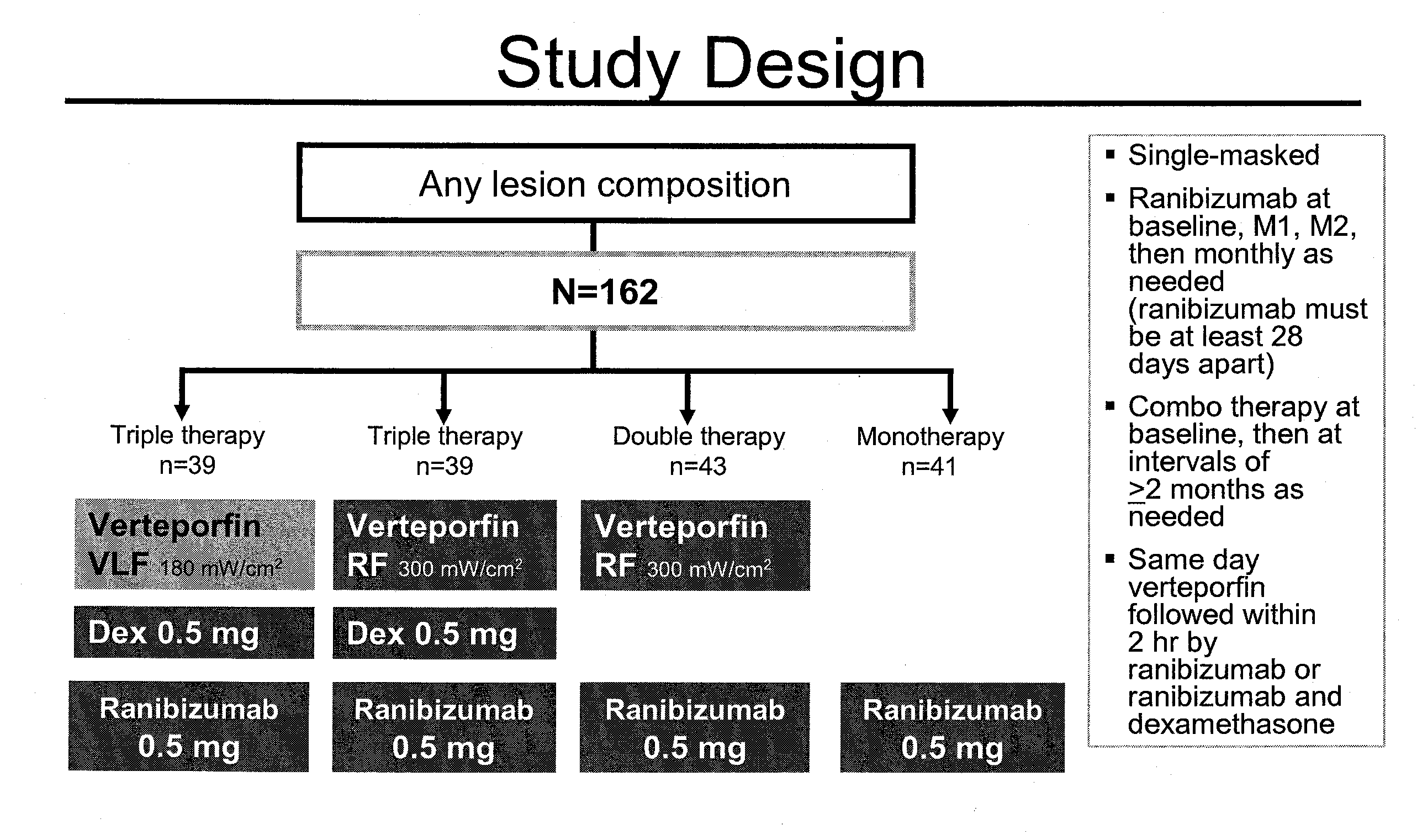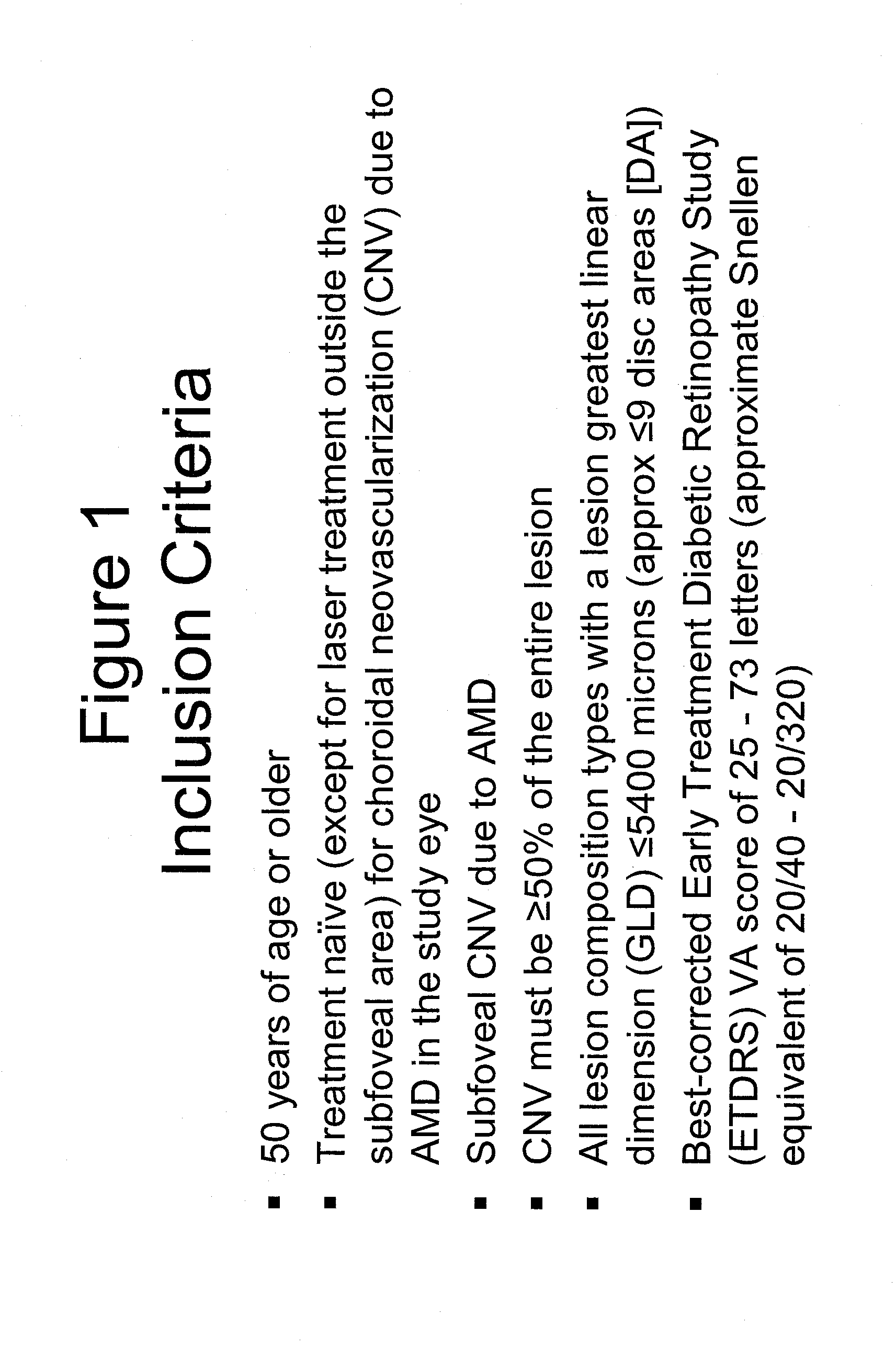Photodynamic therapy for conditions of the eye
a technology applied in the field of photodynamic therapy and compositions for treating ocular conditions, can solve the problems of severe, irreversible vision loss, blindness in individuals, severe and irreversible vision loss, etc., and achieve the effect of acceptable visual acuity outcomes
- Summary
- Abstract
- Description
- Claims
- Application Information
AI Technical Summary
Benefits of technology
Problems solved by technology
Method used
Image
Examples
example 1
Study Design
[0119]The study is a 24-month randomized, controlled trial designed to evaluate 3 combination treatment regimens: (1) very low-fluence vPDT (15 J / cm2) combined with ranibizumab (0.5 mg) and dexamethasone (0.5 mg); (2) half-fluence vPDT (25 J / cm2) combined with ranibizumab and dexamethasone; and (3) half-fluence vPDT combined with ranibizumab. These regimens are compared with ranibizumab monotherapy in patients with subfoveal choroidal neovascularization (CNV) due to AMD. Inclusion criteria includes ≧50 years old; naïve to AMD treatment; best-corrected VA (BCVA) letter score of 73-24; subfoveal CNV due to AMD; and lesion size <9 DA. Patients (N=160) are randomly assigned to 1 of the 4 treatment arms at baseline, receive 1 initial treatment, and are to be evaluated for retreatment every month based on novel criteria using OCT and FA. Patients in the ranibizumab monotherapy group receive mandatory dosing at months 1 and 2, and as needed thereafter based on the same retreatm...
example 2
Materials and Methods
[0124]Dexamethasone Sodium Phosphate Injection, USP 10 mg / mL in 1 mL is used in the study. (Baxter Healthcare Corporation, Deerfield, Ill., USA or Sandoz Canada Inc.) Each milliliter contains dexamethasone sodium phosphate equivalent to 10 mg dexamethasone phosphate or 8.33 mg dexamethasone. The inactive ingredients in this formulation are sodium sulfite anhydrous, sodium citrate anhydrous, and benzyl alcohol (preservative) in Water for Injection.
[0125]Randomization occurs on the day of the first treatment to one of the following groups:[0126]Lucentis monotherapy.[0127]Half-fluence Visudyne-Lucentis (V-L) double therapy.[0128]Half-fluence (25 J / cm2) Visudyne-Lucentis-Dexamethasone (V-L-D) triple therapy.[0129]Very low-fluence (15 J / cm2) Visudyne-Lucentis-Dexamethasone (V-L-D) triple therapy.
[0130]Treatments occur within 7 days of baseline FA. Retreatment is according to retreatment criteria in the Lucentis monotherapy group starting at Month 3 and in the combina...
example 3
Study Results
[0140]Groups of patients who had been diagnosed as qualified for experimental treatment of age related macular degeneration in the study set out in Example 1 and 2 above were divided into four groups as shown in FIGS. 1-3, 18 and treated with one of four regimens as set out in FIG. 4 as follows:
[0141]Lucentis 0.5 mg monotherapy:[0142]Day 0, Month 1, and Month 2[0143]PRN (based on retreatment criteria) with monthly assessments Months 3-12[0144]PRN (based on retreatment criteria) to Month 21, with assessments at least every 3 months after Month 12 to Month 24[0145]All Lucentis injections must be ≧28 days apart
[0146]Visudyne-Lucentis double therapy with half-fluence (25 J / cm2: 300 mW / cm2 for 83 seconds) Visudyne followed within 2 hours by intravitreal Lucentis 0.5 mg:[0147]Day 0[0148]Assessments monthly to Month 12. Double therapy will be given PRN (based on retreatment criteria), but at no less than 2-month (55-day) intervals. If treatment is needed in an intervening mont...
PUM
| Property | Measurement | Unit |
|---|---|---|
| Time | aaaaa | aaaaa |
| Time | aaaaa | aaaaa |
| Time | aaaaa | aaaaa |
Abstract
Description
Claims
Application Information
 Login to View More
Login to View More - R&D
- Intellectual Property
- Life Sciences
- Materials
- Tech Scout
- Unparalleled Data Quality
- Higher Quality Content
- 60% Fewer Hallucinations
Browse by: Latest US Patents, China's latest patents, Technical Efficacy Thesaurus, Application Domain, Technology Topic, Popular Technical Reports.
© 2025 PatSnap. All rights reserved.Legal|Privacy policy|Modern Slavery Act Transparency Statement|Sitemap|About US| Contact US: help@patsnap.com



